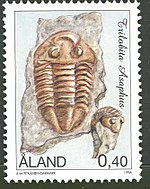Postal history of Finland
The history of the post office in Finland dates back to the 17th century, although Finland did not gain independence until 1917 .
Swedish time
The then governor general of Finland, the Swedish Count Per Brahe the Younger (1602–1680), founded the postal system in Finland in the 17th century. From the beginning, the post was also accessible to the general public. The first postal connections connected the two capitals Stockholm and Åbo (Turku) from 1638 , and there were also postal connections to the interior of Finland. The mail was initially carried by mail runners (Swedish: Postlöpar ) or by rowing and sailing boats ( post office farmers on the Åland Islands ). Here, too, the development continued with mail riders and mail drives.
Finnish Post in the Russian Empire

After Finland was annexed to the Russian Empire (1809), a post office was established in Åbo, which was moved to the new capital Helsingfors in 1818 . In the same year a Finnish postal order was published. The first postage stamps appeared on March 3, 1856. The railway line between Helsingfors and Tavastehus , opened in 1862, was used to transport mail. In 1890 the Finnish postal system lost its independence.
Russian Post
On May 1, 1891, Russian fees and postage stamps were introduced in Finland . In addition, the Finnish stamps initially retained their validity for postage paid within the Grand Duchy and for those sent abroad. From January 1, 1892, postage for items to Russia could no longer be paid in Finnish postage stamps. On August 1, 1900, the Finnish postage stamps were no longer approved for international mail, only to be completely eliminated by the end of 1900.
Finnish Post
With the Russian October Revolution in 1917, the independent state of Finland was formed. An ordinance of July 26, 1918 repealed all previous orders.
The post office in Helsinki ( Swedish Helsingfors ) divided the country into eight districts, which were placed under an inspector. At post offices there were first class post offices with the subordinate second class post offices, which in turn were divided into five classes.
The compulsory mail extended to letters. Some authorities, civil servants and scientific societies enjoyed exemption from fees and postage. Where “free of charge” includes postage, insurance and registration fees, “free of postage” only includes postage.
On January 1, 1963, a currency devaluation was carried out and new stamps were issued. The stamps issued from 1954 were still valid at 1/100 of the face value.
The Åland Islands have had their own postage stamps since 1984 and, since 1993, Åland Post has its own postal administration.

With the introduction of the euro on January 1, 2002, all previously issued postage stamps from Finland and Åland became invalid. Instead of the face value in euros, most postage stamps only indicate the class of carriage.
literature
- Manual dictionary of the postal system , published by Bundespost, Frankfurt am Main, 1953, p. 271
- Postal administrations introduce themselves: Finland. In: Deutsche Briefmarken-Revue issue No. 3/2002, p. 37 f
- Bob Lamb: Republic of Finland. In: American Philatelist May 2009 Edition; from the series of articles / category Worldwide In A Nutshell
Web links
- Brief history of the Finnish Post on the Postal Museum homepage , accessed on August 16, 2010
- Åland Posten homepage , accessed 16 August 2010
